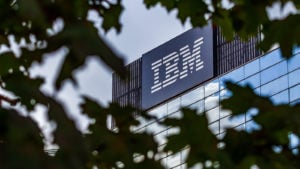If Congress fails to reach an agreement before 12:01 a.m. on Oct. 1, the government will experience a shutdown since the current spending laws are set to expire on Sept. 30. As the possibility looms closer, President Biden and his administration officials have started to warn about the potential ramifications of a government shutdown. Notably, they are urging the Republican Congress to seek a resolution to their spending deadlock.
Economists have conveyed concerns regarding the potential impact of a shutdown on the fourth fiscal quarter, especially in an already fragile stock market. However, this makes it the perfect time to invest in stable sure-to-grow companies that only have positive outlooks. Here are three stocks representing such companies to consider buying in the shadow of the government shutdown.
International Business Machines (IBM)

International Business Machines (NYSE:IBM) is a multinational technology corporation that specializes in providing infrastructure, software, and consulting services to companies. IBM offers a broad selection of tools that assist businesses in analyzing large data sets, cloud infrastructures, and even building their own machine learning models, which you may know better as artificial intelligence (AI).
The stock is up 3.79% YTD, with a median 12-month price target of $145.00 and a range spanning from a low of $110.00 to a high of $188.00. Furthermore, IBM is forecasted to hit $196 by the end of 2025, currently sitting at $146.91 per share.
Since IBM’s inception, the company has had a past filled with innovation and deep research. In the early 2000s, the idea of quantum computing was introduced by the corporation, which made it possible for AI systems—the industry that is currently booming around people—to function more quickly. The revenue of the IT services industry in the United States is projected to grow at a CAGR of 6.70%, or an increase from $454.7 billion to $628.8 billion by 2028. Every year, this industry detects new trends, and following the pandemic, businesses are starting to note the advantages that the IT behemoth IBM can provide.
Over the years, IBM’s financial health has remained consistent and solid. In 2022, the company generated over $60.5 billion in revenue and an impressive $9.3 billion in free cash flow. IBM’s revenues generated from the software, consulting, and infrastructure services were up by at least 12% respectively.
EPS growth in 2022 represented a YoY change of 15.13%, from 7.93 in 2021 to 9.13. Partnerships with well-respected businesses such as SAP (NYSE:SAP), Microsoft (NASDAQ:MSFT), and Amazon’s (NASDAQ:AMZN) AWS account for over $1 billion in revenue in 2022. Based on IBM’s strong revenue growth and a levered FCF margin of 16.64%, the company has a strong foundation for its expansion over the long term.
IBM’s newest invention in the world of AI is called watsonx. The AI watsonx includes 3 platforms that businesses can gain access to: watsonx.ai, watsonx.data, and watsonx.governance. Users are enabled to build generative AI models that they can train and integrate machine learning capabilities into their models. The data platform helps firms scale their data analytics and AI workloads. To manage these giant data sets, watsonx.governance allows users to fully understand what happens to their data and aids in keeping an eye on the company’s AI operations. These platforms are already being used to improve mobility by tech behemoths like Intel (NASDAQ:INTC), SAP, and Samsung.
IBM is a sound investment for investors who are looking to gain an edge in the booming market of AI in the long run.
Micron Technology Incorporated (MU)

Micron Technology Incorporated (NASDAQ:MU) is a global leader in the semiconductor sector known for its design and manufacturing of innovative memory and storage solutions. The company is also one of the most significant suppliers for the Magnificent 7.
MU is up 34.80% YTD as of September 21, currently sitting at $67.90 per share. Wall Street Journal analysts give MU approximately 23 buy ratings, with a median 12-month price target of $80, ranging from $46 to $108.76.
The semiconductor market is forecasted to increase at a CAGR of 7.42% in the course of the next four years. This sector in 2023 is expected to reach $533 billion and is anticipated to gain up to a $736.40 billion market volume by 2027. The market for semiconductor chips is expected to experience a significant surge due to the aftermath of COVID-19, through the automotive and smart appliances sectors.
MU’s financials are faring well, with 2022 revenue ending at $30.76 billion, marking an 11.02% jump YoY. The company also recorded an impressive free cash flow of $1.49 billion, or a 277.78% increase YoY. This metric is crucial because it provides a glimpse of just how much cash the company has to draw on. In Q2, MU beat EPS expectations by 8.74%, with a forecasted price of $-1.57 to a reported price of $-1.43. The GAAP outlook for MU’s revenue for Q4 is currently anticipated to reach $3.90 billion.
Micron over the years has brought numerous innovations to the market, but its most innovative invention yet is the high-bandwidth memory (HBM). The HBM is a dynamic random access memory (DRAM) that has the potential to unleash AI to its fullest. AI has seen a rapid spread encompassing a myriad of sectors, from automobile assembly to AI toothbrushes. The HBM3 Gen2 chip enables users to build and train their AI models more efficiently than using a traditional 12-layered 24GB memory card. MU’s chip can produce the traditional 24GB memory with just 8 layers, displaying the edge that this company has over its rivals.
Considering the wide array of markets and giant clients that Micron supplies to, this company is poised for long-term growth.
Dorian LPG (LPG)

Dorian LPG (NYSE:LPG) is a liquified petroleum gas shipping company focused on providing safe, reliable, and clean transportation of LPG. Dorian LPG Ltd. owns a fleet of 21 very large gas carriers (VLGC) with an average age of 8.3 years beating the global VLGC average age of 10.8 years. This demonstrating its commitment to reduce environmental impacts and optimize transportation efficiency. More modern vessels allow for more efficient transportation, reducing environmental impacts.
LPG stock is currently valued at $29.38 with a YTD growth of 68% and an annual dividend yield of 22.97%. Yahoo! Finance has indicated that 6 analysts have estimated price targets ranging from a low of $23 to a high of $30, with a mean of $26.22. Yahoo! Finance shows that 3 analysts recommend buying in September.
Dorian LPG Ltd. reported Q1 2024 earnings with an income of $51.7 million growing 208.4% YoY. This is with a diluted EPS of $1.28 that grew 206% YoY. According to Yahoo! Finance, the global Liquefied Petroleum Gas (LPG) market size is expected to reach a valuation of $380.3 billion by 2030, growing at a 7.21% CAGR. LPG is a clean-burning fuel that will rise in demand as the world shifts towards reducing environmental impact.
Earlier this year, Dorian LPG Ltd. signed a partnership agreement with the Mærsk Mc-Kinney Møller Center for Zero Carbon Shipping, demonstrating their commitment to decarbonization. This tactic is particularly beneficial in the long run as governments such as the EU have implemented carbon taxes on their respective economies. Thus, Dorian LPG positioned to stand out amongst competitors, experiencing long-term growth and profitability as a result.
With such in mind, Dorian LPG Ltd. would be a wonderful addition to your watchlist as it pays high dividends and is historically a profitable company.
On the date of publication, Michael Que did not have (either directly or indirectly) any positions in the securities mentioned in this article. The opinions expressed in this article are those of the writer, subject to the InvestorPlace.com Publishing Guidelines.
The researchers contributing to this article did not hold (either directly or indirectly) any positions in the securities mentioned in this article.
